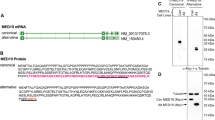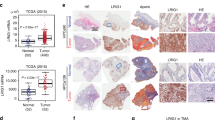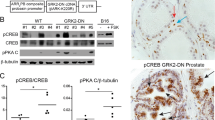Abstract
We have identified a gene that is highly expressed in the androgen-dependent prostate cancer cell line, LNCaP. Sequence analysis revealed that it was identical to a recently cloned gene designated TMEFF2, which encodes a transmembrane protein containing an epidermal growth factor (EGF)-like motif and two follistatin domains. This gene was highly expressed only in primary samples of normal prostate and prostate cancer as well as normal brain. Expression of the gene was controlled by androgen as shown by dihydrotestosterone markedly increasing TMEFF2 expression in LNCaP cells. Also, androgen-dependent human prostate cancer xenografts (CWR22) expressed high levels of TMEFF2 and these levels markedly decreased by day 10 after castration of the mice. Furthermore, a large number of androgen-dependent xenografts (CWR22, LuCaP-35, LAPC-4AD, LAPC-9AD) exhibited higher levels of TMEFF2 mRNA than androgen-independent xenografts (CWR22R, LAPC-3AI, LAPC-4AI, LAPC-9AI). Ectopic expression of TMEFF2 in DU145 and PC3 cells resulted in their prominent inhibition of growth. Taken together, the results demonstrate that TMEFF2 is a androgen-regulated gene, which can suppress growth of prostate cancer cells and our xenograft data show that escape of prostate cancer cells from androgen modulation causes them to decrease their expression of this gene, which may result in their more malignant behavior.
This is a preview of subscription content, access via your institution
Access options
Subscribe to this journal
Receive 50 print issues and online access
$259.00 per year
only $5.18 per issue
Buy this article
- Purchase on Springer Link
- Instant access to full article PDF
Prices may be subject to local taxes which are calculated during checkout






Similar content being viewed by others
References
Abreu-Martin MT, Chari A, Palladino AA, Craft NA, Sawyers CL . 1999 Mol. Cell. Biol. 19: 5143–5154
Agus DB, Cordon-Cardo C, Fox W, Drobnjak M, Koff A, Golde DW, Scher HI . 1999 J. Natl. Cancer Inst. 3: 1869–1876
Amler LC, Agus DB, LeDuc C, Sapinoso ML, Fox WD, Kern S, Lee D, Wang V, Leysens M, Higgins B, Martin J, Gerald W, Dracopoli N, Cordon-Cardo C, Scher HI, Hampton GM . 2000 Cancer Res. 60: 6134–6141
Appella E, Weber IT, Blasi F . 1988 FEBS Lett. 231: 1–4
Benedit P, Paciucci R, Thomson TM, Valeri M, Nadal M, Caceres C, de Torres I, Estivill X, Lozano JJ, Morote J, Reventos J . 2001 Oncogene 20: 1455–1464
Campbell MJ, Gombart AF, Kwok SH, Park S, Koeffler HP . 2000 Oncogene 19: 5091–5097
Chen T, Wang LH, Farrar WL . 2000 Cancer Res. 60: 2132–2135
Craft N, Shostak Y, Carey M, Sawyers CL . 1999 Nat. Med. 5: 280–285
Culig Z, Hobisch A, Cronauer MV, Radmayr C, Trapman J, Hittmair A, Bartsch G, Klocker H . 1994 Cancer Res. 54: 5474–5478
Engler DA, Montelione GT, Niyogi SK . 1990 FEBS Lett. 271: 47–50
Gregory CW, Hamil KG, Kim D, Hall SH, Pretlow TG, Mohler JL, French FS . 1998 Cancer Res. 58: 5718–5724
Hisatake J, O'Kelly J, Uskokovic MR, Tomoyasu S, Koeffler HP . 2001 Blood 97: 2427–2433
Horie M, Mitsumoto Y, Kyushiki H, Kanemoto N, Watanabe A, Taniguchi Y, Nishino N, Okamoto T, Kondo M, Mori T, Noguchi K, Nakamura Y, Takahashi E, Tanigami A . 2000 Genomics 67: 146–152
Hsieh TY, Ng CY, Mallouh C, Tazaki H, Wu JM . 1996 Biochem. Biophys. Res. Commun. 2231: 141–146
Klein KA, Reiter RE, Redula J, Moradi H, Zhu XL, Brothman AR, Lamb DJ, Marcelli M, Belldegrun A, Witte ON, Sawyers CL . 1997 Nat. Med. 3: 402–408
Kupprion C, Motamed K, Sage EH . 1998 J. Biol. Chem. 273: 29635–29640
Lau KM, LaSpina M, Long J, Ho SM . 2000 Cancer Res. 60: 3175–3182
Liang G, Robertson KD, Talmadge C, Sumegi J, Jones PA . 2000 Cancer Res. 60: 4907–4912
Miller EJ . 1999 Cancer Metastasis Rev. 17: 353–360
Patel K . 1998 Int. J. Biochem. Cell. Biol. 30: 1087–1093
Patthy L, Nikolics K . 1993 Trends Neurosci. 16: 76–81
Robinson D, He F, Pretlow T, Kung HJ . 1996 Proc. Natl. Acad. Sci. USA 93: 5958–5962
Russell PJ, Bennett S, Stricker P . 1998 Clin. Chem. 44: 705–723
Tilley WD, Buchanan G, Hickey TE, Bentel JM . 1996 Clin. Cancer Res. 2: 277–285
Uchida T, Wada K, Akamatsu T, Yonezawa M, Noguchi H, Mizoguchi A, Kasuga M, Sakamoto C . 1999 Biochem. Biophys. Res. Commun. 266: 593–602
Veldscholte J, Voorhorst-Ogink MM, Bolt-de-Vries J, van Rooij HC, Trapman J, Mulder E . 1990 Biochim. Biophys. Acta. 105: 187–194
Visakorpi T, Hyytinen E, Koivisto P, Tanner M, Keinanen R, Palmberg C, Palotie A, Tammela T, Isola J, Kallioniemi OP . 1995 Nat. Genet. 9: 401–406
Wainstein MA, He F, Robinson D, Kung HJ, Schwartz S, Giaconia JM, Edgehouse NL, Pretlow TP, Bodner DR, Kursh ED, Resnick MI, Seftel A, Pretlow TG . 1994 Cancer Res. 54: 6049–6052
Whang YE, Wu X, Suzuk H, Reiter RE, Tran C, Vessella RL, Said JW, Isaacs WB, Sawyers CL . 1998 Proc. Natl. Acad. Sci. USA 95: 5246–5250
Xu J, Kalos M, Stolk JA, Zasloff EJ, Zhang X, Houghton RL, Filho AM, Nolasco M, Badaro R, Reed SG . 2001 Cancer Res. 61: 1563–1568
Xu LL, Shanmugam N, Segawa T, Sesterhenn IA, McLeod DG, Moul JW, Srivastava S . 2000 Genomics 66: 257–263
Young J, Biden KG, Simms LA, Huggard P, Karamatic R, Eyre HJ, Sutherland GR, Herath N, Barker M, Anderson GJ, Fitzpatrick DR, Ramm GA, Jass JR, Leggett BA . 2001 Proc. Natl. Acad. Sci. USA 98: 265–270
Zhao XY, Feldman D . 2001 Steroids 66: 293–300
Zitzelsberger H, Engert D, Walch A, Kulka U, Aubele M, Hofler H, Bauchinger M, Werner M . 2001 Br. J. Cancer. 84: 202–208
Acknowledgements
This work was supported by National Institutes of Health Grant CA26038-20, Aron Eschman Fund, Parker Hughes Fund, C. and H. Koeffler Fund, Ko-So Foundation and Israel Humanitarian Fund. HP Koeffler is the holder of the Mark Goodson Chair in Oncology and is a member of the Jonnson Cancer Center.
Author information
Authors and Affiliations
Corresponding author
Rights and permissions
About this article
Cite this article
Gery, S., Sawyers, C., Agus, D. et al. TMEFF2 is an androgen-regulated gene exhibiting antiproliferative effects in prostate cancer cells. Oncogene 21, 4739–4746 (2002). https://doi.org/10.1038/sj.onc.1205142
Received:
Revised:
Accepted:
Published:
Issue Date:
DOI: https://doi.org/10.1038/sj.onc.1205142
Keywords
This article is cited by
-
Reformation of the chondroitin sulfate glycocalyx enables progression of AR-independent prostate cancer
Nature Communications (2022)
-
TMEFF2 promoter hypermethylation is an unfavorable prognostic marker in gliomas
Cancer Cell International (2021)
-
The DNA methylation landscape of advanced prostate cancer
Nature Genetics (2020)
-
Genome-wide effects of social status on DNA methylation in the brain of a cichlid fish, Astatotilapia burtoni
BMC Genomics (2019)
-
Methylation of TMEFF2 Gene in Tissue and Serum DNA from Patients with Non-Small Cell Lung Cancer
Molecules and Cells (2012)



